Dance with Life
vol.3
Dancing Together: Yosakoi
Hibiki, the Tokai University Yosakoi Dance Club
Yusuke, Kanagawa prefecture
Rikako, Kanagawa prefecture
2017.02.01
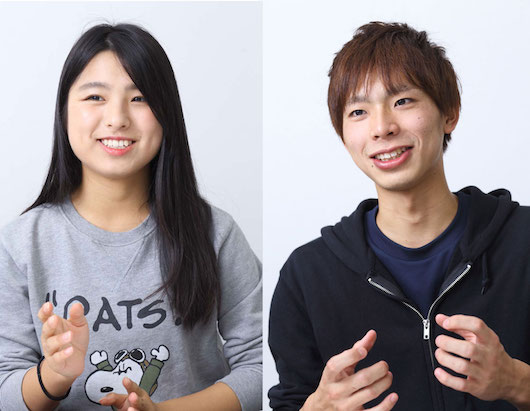
©You Sung Gil
Rikako (left) and Yusuke
"Yosakoi" is a kind of group dancing based mainly on "yosakoi-bushi" and "soran-bushi," which were folk songs traditionally played to accompany dancing at local festivals. It first appeared in Shikoku island's Kochi prefecture in the 1950s and spread throughout the country in the 1990s. Today yosakoi festivals are held on a large and small scale, such as Kochi prefecture's Yosakoi Matsuri, Hokkaido's Yosakoi Soran Matsuri, and the Tokyo Yosakoi Matsuri, from early spring through late autumn each year.
"Yosakoi chimu" (yosakoi teams) have been founded in local communities, schools, and various organizations. Each team devises not only its dance steps but its own costumes, style of narimono clappers, and music. We asked two members of the Tokai University Yosakoi Club, named "Hibiki" (which means "sound," "resonance," "echo") to describe for us the attraction of yosakoi dancing.
What is "yosakoi"?
Q: What kind of dancing is yosakoi?
Rikako: In our club, we perform four-and-a-half-minute dances to music that follow the standard rules of yosakoi festivals including the "Yosakoi Naruko Odori" melody and having naruko clappers in our hands. Other aspects, like choreography, costumes, and music is unrestricted and up to us.
Yusuke: Yosakoi dancing differs from one part of the country to another and is roughly divided between the Kanto region and the Kansai region. Kansai-style yosakoi uses quite a few props, parasols, and flags, and is more extravagant as far as their sets are concerned, sometimes with very elaborate theatrical backdrops. The main feature of Kanto yosakoi is the orderly line-ups of the dancers; small props are used but rarely anything large or involving backdrop sets. In Kansai yosakoi, not all the dancers perform at once, with some members assigned to wave the flags and others to performing in the spotlight, so the composition of the performance is different.
Hibiki is actually a "hybrid yosakoi team"! In 2015 we performed like a Kansai team and this year in 2016 like a Kanto team, so we're a group that can handle either style.
Everyone Contributes to the Performance
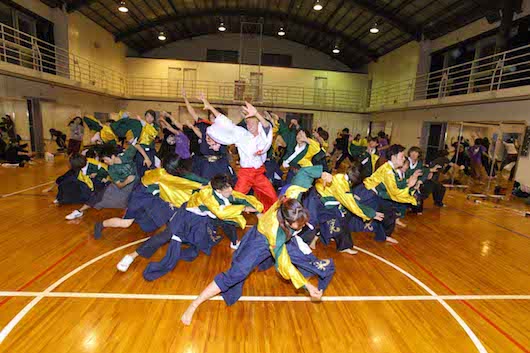
©You Sung Gil
Preparing for the school festival (gakuensai), Hibiki practices in the gymnasium.
Q: Please tell us about Hibiki.
Yusuke: We are an officially recognized university club founded in 2007, and I am the president of the club this year. Right now we have around 70 members. Last year, membership was around 40-50, but this year nearly 40 freshmen joined our ranks. Some other university clubs bring in students from different universities, and sometimes number over 100, but Hibiki's members are all Tokai University students. The ratio of men to women in the club is 1:2, with women pretty much in the majority.
Rikako: Most of the members are Shonan campus students, but I participate from the Yoyogi campus.
Q: What festivals do you participate in?
Yusuke: Yosakoi festivals are being held all over the country, so we choose the ones we want to join. Every year we make long-distance trips to participate in the Yosakoi Soran Matsuri in Hokkaido, the Niigata So-Odori Matsuri in northern Honshu, and the Hamamatsu Ganko Matsuri in Shizuoka prefecture. Closer to home, we appear in the Tokyo Yosakoi Matsuri, the Hamakoi Matsuri in Yokohama, and the Shonan Yosakoi Matsuri in Hiratsuka. In 2015 we received second prize at the Shonan Yosakoi Matsuri and other prizes at the festivals in Yokohama, Niigata, and Tokyo. In 2016 we received a prize at the Tokyo Yosakoi festival.
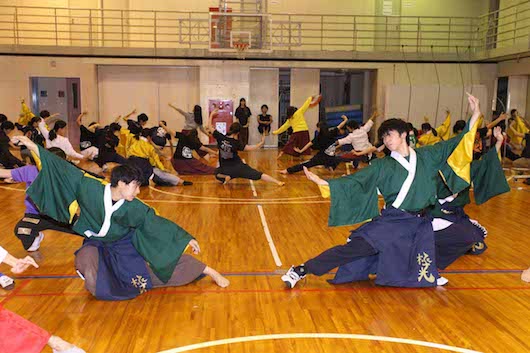
©You Sung Gil
Q: May I ask what motivated you to join the yosakoi club?
Yusuke: In my case, I got interested when I was invited by a friend to visit the club's practice. That was the first time I had ever seen yosakoi performed. I was no dancer at the time, but I was attracted by the fact that it is a style of dancing not measured by the performance of each individual but is the product of everyone working together.
Rikako: I, too, saw a Hibiki performance for the first time at the presentation made by the club for incoming freshmen students. As with Yusuke, I was encouraged to attend by a friend who was already a member. Watching the club members, I noted that, though they were having fun and fooling around during their breaks, when they began to practice, they changed into serious performers intent on perfecting their art. I really admired that. I didn't have any particular talent for dance, so at first I found it quite a challenge to remember the steps, but I have gradually become engrossed in it.
Yusuke: Once in the club, we get really busy and we have lots of expenses with the long-distance trips, the costumes, and so on, but we don't begrudge it at all because it's so much fun!
Q: Do you have exchanges or contact with yosakoi clubs at other universities?
Yusuke: Yes, our ties with fellow university yosakoi clubs are pretty strong. In May and June there are events when student yosakoi clubs of the Kanto region get together for meals and recreation. Sometimes as many as 300 people get together. In February there is a social event called Jan-jan Yosakoi, at which Kanto university yokakoi clubs gather to put on dances, play games like kibasen (shoulder wars; see https://www.tjf.or.jp/deai/contents/teacher/mini_en/html/taiiku.html), and organize other activities to get to know each other.
One New Original Performance a Year
Q: About how much do you practice?
Rikako: We have practice twice a week, in the gymnasium or in open spaces or corridors in the school. Regular practice is two hours each time from 5:00 to 7:00 p.m., but after that we usually stay for individual practice, and if our classes are over early, sometimes we go in for individual practice before the regular practice begins.
This year we are going to dance a piece featuring large folding fans and very "feminine" moves, so I have been doing quite a bit of independent practice, imitating a friend who is very skillful at fan-dancing and making videos of my dancing to compare with hers.
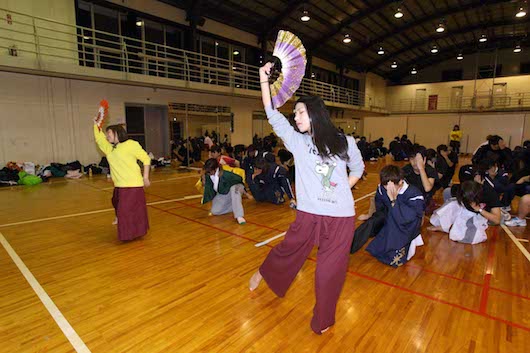
©You Sung Gil
Rikako practices "fan dancing."
Q: How do you create your performance pieces?
Yusuke: We make one original piece each year. In 2016 we created a piece called "Koto no ha tsumugi" (Spinning Out Words) on the theme of expressing our thoughts in words and the difficulty of transmitting them to others. In 2015, our new piece was "Kyokko" (Aurora) which is about a young man attracted to the light. The story behind the piece is a world where everything is rigidly controlled and standardized and everyone lives in fear, hiding their true selves from others and going along with the rules. Then among the people is a young man who discovers a fascinating light.
In October 2016, the third-year students retired from the club and as a second-year student I became the president of the club. We will present our 2017 original piece in June, so we are in the process of creating it now. We have chosen the name of the piece and the story but we're still working on the details [of the choreography, costumes, and so on]. We plan to make this year's piece completely different from the 2016 piece.
Rikako: Once the story is decided, then we choose people to take charge of specific tasks, like the choreography, the costumes, the music, etc. Even though we might decide on the choreography, we keep on adjusting and improving it as we go. The line-ups will differ depending on who performs and sometimes depending on what kind of stage we are performing on. The members in charge of choreography make revisions as needed for each performance. The dances we perform can differ quite a bit, therefore, depending where we perform.
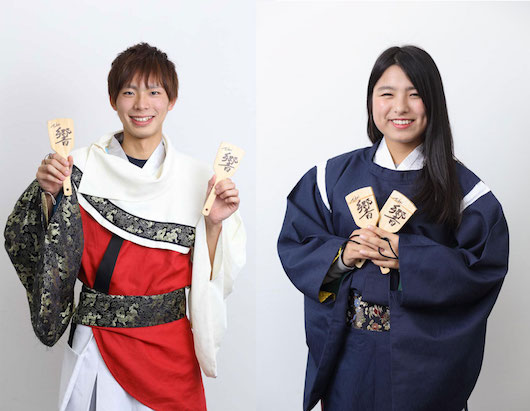
©You Sung Gil
A costume for the "Koto no ha tsumugi" dance (left) and for "Kyokko" (right).
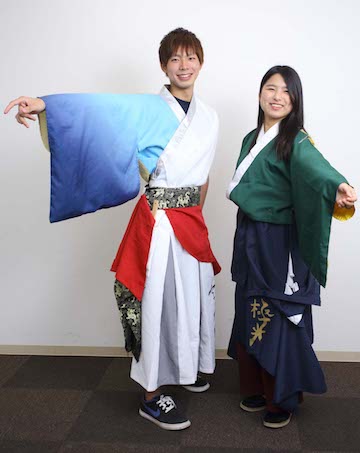
©You Sung Gil
The costumes are two-layered, enabling the dancers to do a quick change in mid-performance, showing another guise as they dance.
A Team with Spontaneous Smiles
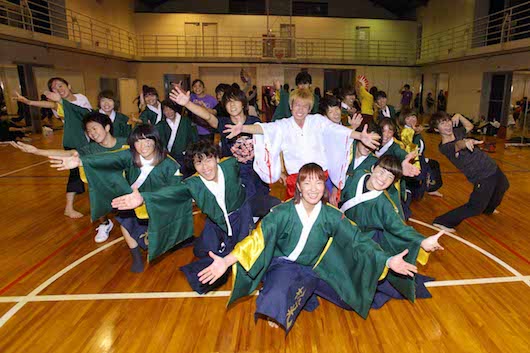
©You Sung Gil
Q: Do you think you have changed in some way as a result of your yosakoi dancing?
back row, out of sight. But as we've danced at festivals, I've begun to enjoy it immensely and now, I'm more eager to show off what I can do, and my desire to be more in the forefront of the dancers has fueled my desire to improve my dancing.
Rikako: Before I joined the club, my interests were always shifting from one thing to another and never stuck to any one pursuit for very long, but after discovering yosakoi, I realized that this was something I could stay with and continue for a long time. Since we dance as a group and I don't want to cause trouble for the others, I feel the pressure to work hard and improve my performance. This year I'm determined to lead younger members more actively. Yes, I think I have changed.
Q: In what directions do you want to lead the team in the coming year?
Yusuke: Now that I'm president, I'm hoping to change the club in ways that I had been thinking about during practice and when giving performances. I'm hoping to get everyone to be able to sing out in full voice and express energy like a university student team should. I'd like to see more exuberance and power. Sometimes frictions develop among the members, and I hope we can gradually resolve that sort of thing. I'm hoping it can be a club in which everyone can enjoy themselves. To do that, everyone has to be ready to discuss things until everyone agrees.
Rikako: When members are at odds with each other, the performance doesn't come together well and the audience can tell they aren't enjoying what they are doing. I'm hoping that everyone will find themselves naturally smiling when they perform.
Q: What would you say is the attraction of yosakoi?
Rikako: In a student team, it's probably with their energy and smiling faces that the performers may appear to be enjoying the dancing, but when you see a really experienced adult team perform, you get goose bumps, they're so good. The power of their shouts, the glow on their faces, the skill of their footwork--is just great! When they perform the "rensa" sequences where the dancers move as if in a rippling wave, we can tell how perfectly they have practiced their art.
Yusuke: In Kochi at the So-Odori, the spectators join in the dancing and that's pretty exciting, too. The people who come to see yosakoi are really warm and generous and give us a huge amount of encouragement.
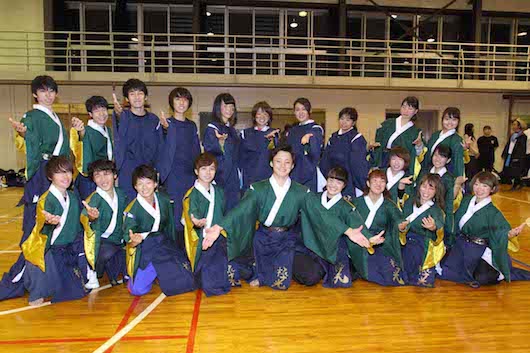
©You Sung Gil
Interview:October 2016
Compilation:Itagaki Tomoko



